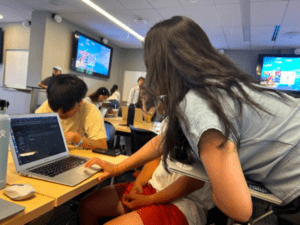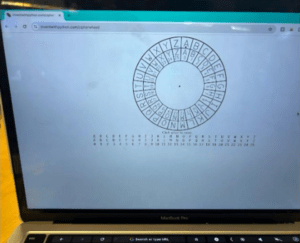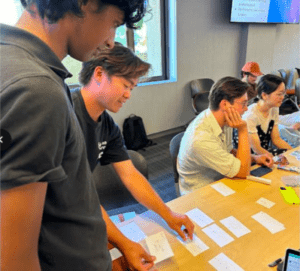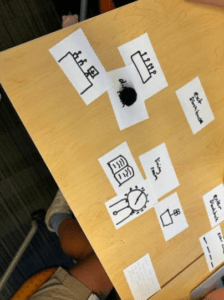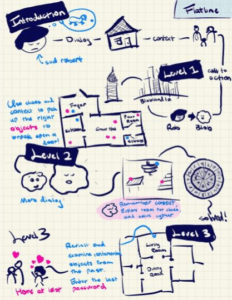Flatline – Final Report
For grading purposes, we would like to be evaluated on Level Design and Narrative Architecture.
Game Link: https://b-salt.itch.io/flatline-demo
Google Drive Link (if itch does not work): https://drive.google.com/file/d/1Su4EXBgT5d48NGZMz9qnUVPK1WZDZYAV/view?usp=drive_link
Playtest Link: https://m.youtube.com/watch?v=g0tywrxQnrw
Artist Statement
Our vision for Flatline came from stories of alien invasions and the movie Caroline, imagining a game that depicted one’s struggle to find their way back home, and quite frankly to their “original selves”. From the ideation stage, we had themes of mystery, loss, and existentialism in mind and aimed for a game that took both the player and the main character out of their comfort zone, into a warped parallel world. We worked to ensure that as the players explore our main character’s (Robert/Blob) story and past choices and reflect on and even fix his mistakes to bring him back to life (his real-life consciousness), they reflect on their own values and choices in life. As students, we all realize that sometimes we get sucked into the motions of life, chasing one deadline after another while losing vision of what matters, like personal growth and close relationships. Sometimes, it takes a rather traumatic event to be confronted with the reality of what matters most, and what makes life worth living. Our game is meant to be the dramatic force that breaks its players out of numbly going through the motions, giving them a thorough shake of mystery and subtle themes of horror to encourage questioning what makes life meaningful. Flatline is a story of fighting to go back “home” and an exploration of the lost pieces of one’s self, both for our character, and players- before we all flatline.
Design Process
During our original ideation process, we brainstormed a wide variety of ideas and concepts and then sifted through them to find the most compelling ones. The following ideas stood out to us: a character finding their way home, a character trying to recover their identity, a game that explores what it means to be human, and a blob character. We decided to go with the blob character for our original vision.
Our concept involved a blob character who, at birth, was separated from their parents and must embark on a journey to return home. During this journey, the blob gains many values and becomes a much more developed character.
First Playtest – Peers in CS 247G + Annabelle
We began by developing a narrative around the blob, starting with the character as a human who gets into an argument with his parents, providing context for why he ends up in the blob world. This narrative was implemented using Twine, along with some original concept art for the blob. Our playtest, conducted by Annabelle (our TA) and a neighboring group from CS 247G, aimed to see if the narrative premise was compelling and if the interactive fiction format in Twine was enjoyable.
The feedback highlighted several positive points: people loved the concept art and appreciated the idea of interactive fiction. However, there were significant challenges. Many testers didn’t engage with the narrative, often not reading through the full text. They found the interface confusing, unsure of which buttons to press, and felt that the choices between actions lacked weight. Simple decisions, like whether to open or ignore a book, offered no puzzle or critical thinking opportunities. Overall, while the aesthetic promise was appreciated, the narrative and interaction design needed substantial improvement to maintain player interest.
Fig. 1 – Playtest 1
Second Playtest – Peers in CS 247G + Krishnan
To address feedback from the first playtest, we used this playtest to see if the narrative and puzzles were compelling, if the difficulty level was appropriate, and if the interface was user-friendly. To this end, we developed a puzzle and fleshed out a full series of stories. We created four characters, each with a designed level and an associated value or lesson to be learned. For the first level, we focused on a character called the Sage, featuring a cipher wheel puzzle. Decoding a string of text into a message (“Thank you”) represented the appreciation of family, the associated lesson. This was implemented in Twine, along with a reworked, more concise introduction and a series of passages with decisions that could lead to hints for the Sage-level puzzle.
The positives were that people were more engaged with the cipher puzzle and showed increased interest in the narrative structure and game format. However, there were challenges: the puzzle was too difficult, and people were confused about how to spin the cipher. Additionally, the multiple-choice format made the correct answer obvious because only one option had the same number of letters as the code (e.g., “eivla aci” -> “thank you,” while other options were “I missed you” and “you’re the best”). The most important insight was that having only one puzzle for the entire game felt underwhelming, and people expressed a desire for more puzzles.
Fig. 2 – Cipher Wheel from Playtest 2
Third Playtest – Peers in CS 247G, Krishnan, Annabelle
For this playtest, our focus was on perfecting puzzle design. We aimed to create a puzzle that was both challenging and reflective of the blobs’ history, with significant stakes in the game’s larger context. We paid special attention to facial expressions and body language, as well as any points of confusion. Due to the complexity of implementing these puzzles in Twine, we created paper prototypes. Caleb acted as the “computer” in a game where players had to navigate from room to room, collecting items and trying to use them to get past a blocked door, ultimately discovering they needed candles to remove the barrier.
This approach proved to be a breakthrough. For the first time, players seemed to genuinely enjoy themselves, experiencing a range of emotions such as fun, frustration, and excitement when solving puzzles. They also expressed confusion, which provided valuable insights. The presence of laughter indicated a significant success, marking a major achievement in our development process.
Fig. 3 – Caleb “Computing” for Krishnan in Playtest 3
Fourth Playtest – Peers in CS 247G, Krishnan, Annabelle
Building on our previous successes, we aimed to create puzzles that would maintain player engagement, reflect the blobs’ history, and introduce more complexity. We designed two additional paper prototypes for levels 2 and 3, with the intention of reworking the cipher puzzle from the first playtest as the final stage.
In Level 2, the player’s goal is to enter a code to open a door. To find the code, the player experiences a flashback to the blob’s fifth birthday and explores the living and dining rooms of their house. Among various items, a grandfather’s clock displaying the time 12:26 provides the password, 1226. In Level 3, the player must find another code by examining a book given by the grandmother, which includes a signed letter revealing the password, Eliza.
Feedback indicated that players enjoyed the second puzzle more than the third, finding the exploration of items interactive and engaging. The process of solving codes was well-received, as players appreciated the challenge. However, the puzzles were too obvious due to insufficient information, with one playtester solving both puzzles in under a minute. Players suggested combining the levels and adding more items to make the puzzle more challenging and to provide more opportunities to learn about the blob’s history through item descriptions.
Fig. 4 – Items from Playtest 4
Final Playtest – Peers in CS 247G
Now that everything is implemented in Twine, we conducted a comprehensive test to ensure the coherence and logical flow of solving puzzles in succession. We specifically assessed narrative investment, observing if players cared about the story by noting their time spent reading passages and their reactions, such as laughs. Additionally, we incorporated original artwork and sound design. Our objectives included identifying any potential roadblocks that might prevent users from progressing in the game, determining where hints might be needed, and evaluating the overall length of the game.
Game Model
Initial decisions about formal elements and values of your game
Game mechanics: Flatline contains many mechanics that are essential to the player experience.
- Clicking the mouse to make a decision: the core mechanic found in Flatline is clicking the mouse to make a decision. As an interactive fiction, Flatline relies upon the choices the player makes to build a story and keep the game engaging. While the game itself has simple mechanics compared to even a 2D platformer, it is the depth of the decisions and the puzzles that make the game fun for the player. All the other mechanics rely upon this single mechanic.
- Inventory system: essential to multiple puzzles in the game, the inventory system allows players to carry items that are used to solve puzzles. Items can change states (such as a candle being lit), provide context to the story, and give players opportunities to explore Blob City.
- Exploration: during specific gameplay segments (such as the Sage Tower), players can explore different rooms and even access flashbacks of Rob’s life. They are able to “walk around” meaning they can click on specific options to enter rooms. Moreso, players are encouraged to read more of the story, choosing options that might not directly lead to the end goal. Instead, these options can provide hints to puzzles or add to the storyline.
- Saving/Rewinding: for players who may want to explore different paths and see how it affects the story, they may reload a previous save. Generally, though, this mechanic is only used when players have a long playthrough and need to pick back up the game at a later time.
Formal Elements (Goals, Rules, Resources, Conflicts, MDA)
- The main goal of Flatline follows the overarching narrative. After a heated disagreement with his family related to the recent death of his golden retriever, Rob runs away from home. However, as he is crossing the street, he is hit by a car. Before completely blacking out, Rob is transported to a world full of blobs called Blob City. In this world, he must meet four blobs who will guide his journey back to the real world before this world collapses. This is a metaphor for Rob waking up from his coma before he dies. It is Rob’s goal to solve the different puzzles presented, learn the values that these blobs instill in him, and escape from Blob City.
- Intro: During the introduction, the background behind Rob’s recent life, the death of his beloved golden retriever, and the events leading up to the car accident are shown to the player. There is relatively little gameplay with a mostly linear storyline, save for one or two different dialogue options. The goal of this gameplay segment is to help the player understand the background behind Rob’s story.
- Sage Tower: The Sage Tower is the first major story arc within Flatline. It follows Rob as he is dropped into Blob City. He sees this tower and has an inkling that this would be a good place to start his exploration. Narrative-wise, the goal of the Sage Tower is to teach Rob the importance of family virtues and appreciating those around him who support him. This arc is led by the Sage, a wise blob who is a mirror reflection of Rob’s grandmother, Eliza. The Sage Tower itself is split into four unique puzzles, each with a lesson to be learnt by Rob/the player.
- Floor 1, Lighting Candles: On this floor, the player explores different rooms, picks up candles, lights them, and burns down debris blocking Rob’s path to climbing the tower. Gameplay-wise, their goal is to find all the candles which are spread out in different rooms by exploring said rooms. Then, they are meant to light the candles either in the kitchen or the fireplace and go burn down the debris. Narratively, the story highlights the fond memories of Rob’s fifth birthday, vividly showing them through the hand-drawn illustrations. This becomes important in the following puzzles.
- Floor 2, Cipher: On this floor, the player first meets the owner of the tower: the Sage. Their interactions with the Sage teach the player kindness and patience, only continuing with the story if Rob interacts with the Sage by compassionate means. The main puzzle of Floor 2, however, is the cipher. The player’s goal is to decipher a phrase by spinning a circle cipher which gives the player the corresponding answer. Again, Rob is taught compassion with this puzzle as the answer is something Rob should have considered from the beginning.
- Floor 3, Passwords: On this floor, the player enters flashbacks of Rob’s life at different periods of time. They are meant to examine various items that are important to him, with some of them being red herrings. The items each correlate to a letter and number, eventually resulting in the player being able to enter the name of a character to pass the floor.
- As it currently stands, our game is only a slice of the first story arc. However, the player learns all of this and Rob grows significantly, even throughout the first arc. From the inner conflict regarding Rob’s grief and coping mechanisms to the outer conflict he has with the Sage, puzzles, and other characters, he learns many lessons that he is meant to apply to future puzzles and interactions as well. Primarily, we hope the player enjoys the narrative of Flatline, but we also hope they get a sense of challenge, discovery, and fellowship while playing the game.
- Values: One of the main points of Flatline is a story about a character returning home, whatever that might mean. From our initial brainstorming sessions, we wanted our game to make the players think and self-reflect on the relationships and people they have met in their lives. We also wanted to explore the difficulties in a coming-of-age story with our own twists and turns. These were the guiding values that shaped Flatline’s story, gameplay, and overall direction.
Over the course of development, Flatline went through several major iterations and changes.
Iteration 1: Brainstorming
From the start, we knew we wanted to have a game heavily focused on narrative and one that emphasized themes of family, exploration of a strange world, and coming of age. We were also at this point considering the possibility of branching narratives where the player character, Robert, would change appearance and abilities in-game upon meeting and interacting with different NPCs in the game. There was also discussion of different endings depending on how the player chose to interact with these NPCs. All of this served to emphasize our main goal: to have the player engage emotionally with the game story and the idea of growing up and changing as you do.
This is also the stage where we underwent several iterations of our central story, especially in trying to figure out who Robert was, his background, and the characters he would meet in this strange alternate “blob” world. In the end, we decided on a story with four main “arcs”, where Robert (in blob form) meets four different blobs, each corresponding to a different family member he can learn a different lesson from.
Iteration 2: Game Engine and Puzzle Design Direction
It was in this iteration that we clarified more so what mechanics we actually wanted to incorporate in our game and through what engine we wanted to achieve these mechanics in. We considered both interactive text-based puzzles in Twine and something closer to a traditional 2D platformer in GameMaker or Unity. We also had several discussions about pursuing a hybrid game—either having it be half-digital, half-analog (i.e. the narrative would be digitally interactive, the puzzles would be physical objects that players would manipulate), or a mix of two different styles of gameplay (transitioning from text-based elements in Twine to puzzles in GameMaker.)
Through our prototypes and initial explorations in both engines, we decided to create our game in Twine to leverage Twine’s natural strengths in conveying the type of interactive narrative we set out to tell. However, Twine came with its own limitations, especially in terms of creating engaging puzzles and balancing the amount of passive reading and active playing that the player was required to do. We also realized from playtesting that we would have to work on conveying the less-interactive portions in visually and audibly engaging ways—thus, the work to produce custom and appealing character designs, graphics, and soundtracks began.
Iteration 3: Puzzle Evolutions
The latter half of our development was heavily focused on creating and refining puzzles that were actually fun to play within the constraints of Twine. It was also at this point we decided to narrow the scope of what we would be creating from an MVP to a slice, from the introduction and through the first arc involving the “sage” character. We also decided that rather than having a single puzzle for the sage arc, we would incorporate multiple.
We went through many versions of the final puzzles that eventually ended up in the final product:
- Circles and Symbols: This was one of our first puzzles prototyped in Twine. It involved asking the players to click through links and “explore” the sage’s tower in order to find what symbols they should turn a set of three magic circles to. This puzzle was pretty simple and simply involved the player clicking on the right links to be told what the symbols were.
- Cipher Wheel: This was the evolution of the Circles and Symbols puzzles—we prototyped having players try to find the right number of spaces to turn a cipher wheel to in order to correctly decode a secret message.
- Candle Lighting and Passwords: In order to add additional environmental design and complexity to our game in a way that was tractable in Twine, we decided to incorporate two puzzles that involved clicking through various digital “rooms” and interacting with the objects in those rooms. For the candle lighting, this involved figuring out an inventory system in Twine that would allow the players to pick up the candles, light them, and burn down a door to progress. For the password puzzle, the original idea involved simply picking out a correct keyword from one of the objects present in a flashback the players could explore.
- Combining Levels: The final iteration of our puzzles involved sequencing the Candle Lighting, Cipher Wheel, and Password stages one after another. The password stage was also made more complex in response to feedback—different objects would now contain references to numbers, which stood for a letter of the alphabet that the player would have to unscramble to reach the final password.
Iteration 4: Polishing
The final iteration involved mostly aesthetic changes, such as reworking some of the narrative and text, as well as cleaning up the flow between different sections of the story and between the different puzzles. All remaining graphics and assets were imported, dialogue boxes and actions were added and stylized, and sections of each page were timed to fade in to provide additional animation and visual interest to the game. Music and sound effects were also incorporated to make for a more complete and immersive player experience.




